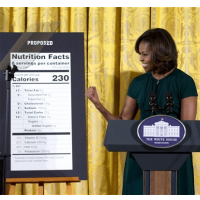FDA Proposes First Major Food Labeling Changes in 22 Years
 Michelle Obama speaks about new food labeling (AP photo)
Michelle Obama speaks about new food labeling (AP photo)
The Obama administration wants to significantly change the rules governing food labels to better inform Americans about the calories and ingredients, particularly sugars, they’re consuming.
The changes are the most significant regarding nutrition labeling in more than two decades, and are likely to spark considerable debate and possibly some pushback from food manufacturers.
Developed by the Food and Drug Administration (FDA), the new labels would make calorie counts much more noticeable—by increasing font size and bolding the characters.
Another major change would alter portion sizes on labels. This change was motivated by the fact that Americans are consuming larger servings than they did when the original labeling requirements were established in the early 1990s.
As it was, the 1990 rules were based on data collected in the 1970s and 1980s about Americans’ eating habits, which demonstrate just how out-of-date the federal rules had become.
“It’s an amazing transformation,” Dr. Margaret A. Hamburg, head of the FDA, told The New York Times. “Things like the size of a muffin have changed so dramatically. It is important that the information on the nutrition fact labels reflect the realities in the world today.”
For instance, under the new plan, 20-ounce bottles of soda would be counted as one serving, instead of 2.5 servings on existing labels.
Food experts say another big change likely to spark controversy and grumbling from industry would create a new line on labels indicating whether sugars were added to food.
Dr. David A. Kessler, former FDA commissioner in the early 1990s, said the “changes put added sugars clearly in the cross hairs.”
“America has the sweetest diet in the world,” he told the Times. “You can’t get to be as big as we’ve gotten without added sweeteners.”
First Lady Michelle Obama, who has campaigned vigorously on health issues, said the added sugars line on labels would inform consumers whether the sweetness they’re enjoying comes from natural sources like fruit or from manufactured ingredients.
The administration promoted the new regulations at a White House event that marked the anniversary of Michelle Obama’s “Let’s Move!” initiative to reduce obesity.
The new labels are intended to make it easier for consumers to make informed decisions about their diets, which is particularly important these days with more than 30% of all adults being obese.
Industry representatives were muted in their response to the proposal, which could cost manufacturers $2 billion to create the new labels. But it would be surprising if their lobbyists didn’t try to amend or stymie the regulations in some way. The FDA is allowing the industry two years to make the changes to their labeling.
If the new rules go into effect, they would be a marked upgrade over the original labeling laws adopted two decades ago.
The Nutrition Labeling and Education Act of 1990 (pdf) required all packaged foods to bear nutrition labels and for all health claims to be consistent with terms defined by the Secretary of Health and Human Services.
Two years later, the government amended the Nutrition Labeling and Education Act by mandating that labels list the “most important nutrients in an easy-to-follow format,” according to the FDA.
-Noel Brinkerhoff
To Learn More:
New F.D.A. Nutrition Labels Would Make ‘Serving Sizes’ Reflect Actual Servings (by Sabrina Tavernise, New York Times)
Significant Dates in U.S. Food and Drug Law History (U.S. Food and Drug Administration)
- Top Stories
- Unusual News
- Where is the Money Going?
- Controversies
- U.S. and the World
- Appointments and Resignations
- Latest News
- Musk and Trump Fire Members of Congress
- Trump Calls for Violent Street Demonstrations Against Himself
- Trump Changes Name of Republican Party
- The 2024 Election By the Numbers
- Bashar al-Assad—The Fall of a Rabid AntiSemite






Comments